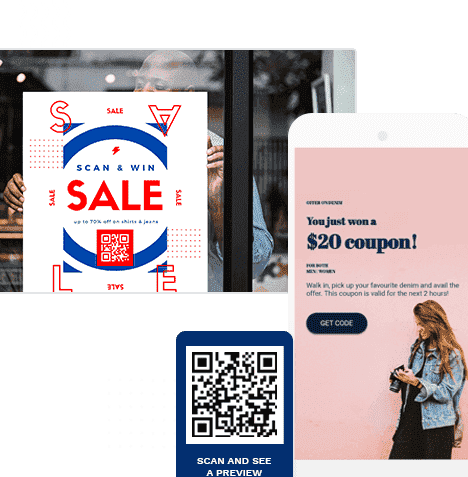QR codes are revolutionizing the retail and e-commerce industry with their cost-effectiveness and convenience. Boldly linking customers directly to products or services, QR codes have become a popular way for businesses to attract and engage with customers. Here are some of the kickass ways that these codes are being utilized:
QR codes are versatile, enhance customer experience, streamline processes and increase revenue. Their growing popularity in retail and e-commerce shows that they will continue to stay relevant.
The basics of QR codes
QR codes, or Quick Response codes, are two-dimensional barcodes that store information in a matrix pattern of squares. Created in 1994 by a subsidiary of Toyota, QR codes were initially used for tracking automotive parts. However, their usage has expanded to a wider range of industries, including retail and eCommerce.
QR codes can store various types of information, including website URLs, contact information, product details, and more. To scan a QR code, users must use their smartphone camera and a QR code reader app. Once scanned, the QR code redirects the user to the specific information encoded within it.
How QR codes are used in retail
Retailers have been utilizing QR codes as a way to connect with customers and provide a more personalized shopping experience. Here are some ways QR codes are used in retail:
– Product information: QR codes are placed on product packaging or in-store displays, allowing customers to scan and access detailed information about the product, including product reviews, specifications, and user manuals.
– Loyalty programs: QR codes can be used as a way to reward loyal customers. Customers can scan QR codes to collect loyalty points, redeem coupons, or unlock exclusive discounts.
– Mobile payments: Retailers can use QR codes as a secure, contactless payment method. Customers simply scan the QR code at the checkout and complete the payment process through their mobile device.
– Interactive experiences: QR codes can be used to create interactive experiences for customers, such as virtual try-on, product demonstrations, or augmented reality experiences.
Benefits of using QR codes in retail and eCommerce
Using QR codes in retail and eCommerce provides several benefits for both retailers and customers:
– Improved customer engagement: QR codes offer a more interactive and engaging shopping experience, allowing retailers to connect with customers on a deeper level.
– Increased sales: QR codes can help retailers drive sales by providing customers with easy access to product information, promotions, and purchase options.
– Enhanced loyalty and customer retention: QR codes can be used to incentivize repeat customers and reward loyal customers, improving customer retention rates.
– Cost-effective marketing: QR codes are a cost-effective way for retailers to implement marketing campaigns without the need for additional resources or materials.
Examples of successful QR code campaigns in retail
Several retailers have successfully incorporated QR codes into their marketing campaigns. Here are some notable examples:
– Walmart: Walmart implemented QR codes on product packaging to provide customers with additional product information and reviews. The campaign led to a 35% increase in sales for products with QR codes.
– Macy’s: Macy’s used QR codes on in-store displays to create a scavenger hunt for customers. Customers who completed the scavenger hunt were entered into a prize drawing, resulting in increased foot traffic and sales.
– Adidas: Adidas incorporated QR codes into their virtual try-on feature, allowing customers to scan a QR code to see how a particular shoe would look on their feet. The campaign resulted in a 6.2% increase in conversion rates.
Tips for designing effective QR codes for retail and eCommerce
When designing QR codes for retail and eCommerce, it’s important to consider the following tips:
– Add a call-to-action: Include a clear call-to-action, such as “Scan for more information” or “Scan to unlock an exclusive discount.”
– Optimize the code for scanning: Ensure that the QR code is high quality and easily scannable by testing it on various devices and in different lighting conditions.
– Test the code before implementation: Test the QR code before implementing it to ensure that it leads to the correct information and functions as intended.
– Make the code visually appealing: Customize the QR code’s colors and design to match the branding of the retailer or product.
– Add branding or a logo: Incorporate the retailer’s logo or branding elements into the QR code to increase recognition and brand awareness.
Potential challenges and solutions for implementing QR codes in retail and eCommerce
Although QR codes offer several benefits for retailers, there are some potential challenges in implementing QR codes in retail and eCommerce. Some of these challenges include:
– Lack of awareness: Some customers may not be familiar with QR codes, leading to confusion or hesitation in scanning them.
– Technical issues: QR codes may not function correctly if the link is broken or if the code is not optimized for scanning.
– Security concerns: QR codes can be used to direct customers to fraudulent websites or mobile apps, leading to security concerns.
– App dependency: Customers need to have a QR code reader app installed on their mobile device to scan the code, which may be an additional obstacle.
To address these challenges, retailers can provide clear instructions on how to scan the QR code, ensure that the code leads to trustworthy and secure websites, and provide assistance to customers who may be unfamiliar with QR codes.
The future of QR codes in retail and eCommerce
As retailers continue to seek out innovative ways to connect with customers, QR codes are likely to remain a popular tool in the retail and eCommerce industries. With the increasing adoption of smartphones and mobile devices, the usage of QR codes is expected to grow. Advances in technology, such as more efficient and secure mobile payment options, virtual try-on features, and augmented reality experiences, are also expected to drive the usage of QR codes in retail and eCommerce.





